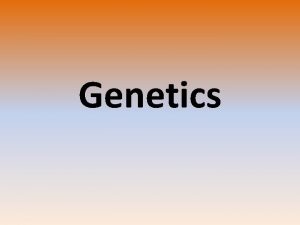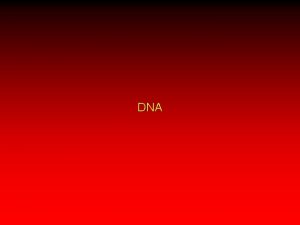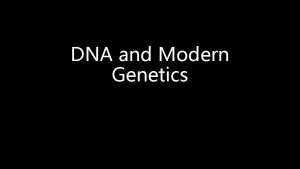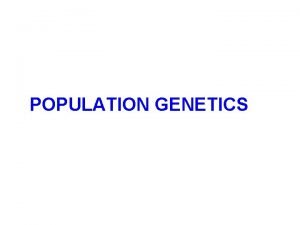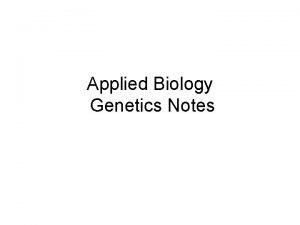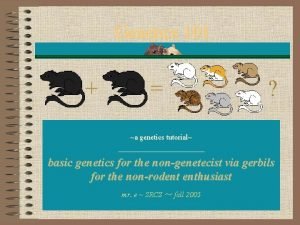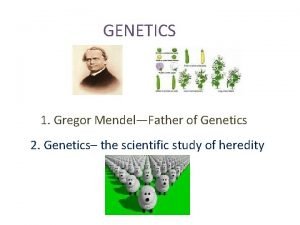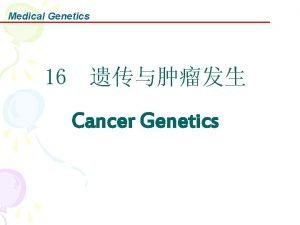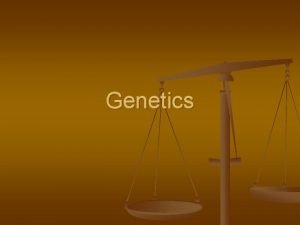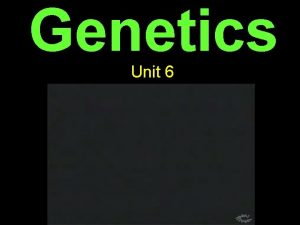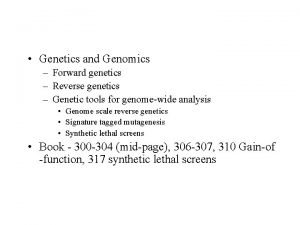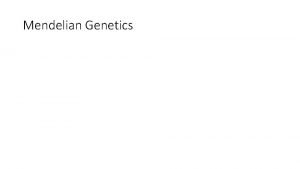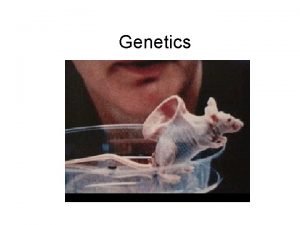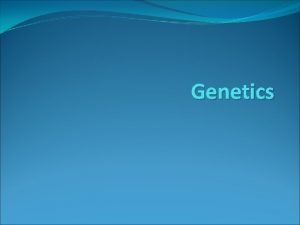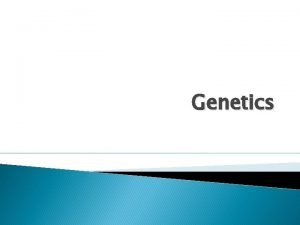DNA GENETICS QUESTION 1 Most of the DNA




































- Slides: 36

DNA GENETICS

QUESTION 1 • Most of the DNA of a human cell is contained in the nucleus. Distinguish between unique and highly repetitive sequences in nuclear DNA. 5 marks

QUESTION 1 - ANSWERS • U=Unique sequences; H= Highly repetitive sequences • U: occur once in genome; H: occur many times; • U: long base sequences; H: short sequences/5– 300 bases; • U: (may be) genes; H: not genes; • U: (may be) translated/coding sequences; H: never translated; • U: small differences between individuals; H: can vary greatly; • U: exons (are unique sequences); H: introns (may be repetitive); • U: smaller proportion of genome; H: higher proportion of genome; • satellite DNA is repetitive; • repetitive sequences are used for profiling; • prokaryotes do not (usually) contain repetitive sequences;

QUESTION 2 • Draw a labelled diagram to show four DNA nucleotides, each with a different base, linked together in two strands. 5 marks

QUESTION 2 - ANSWERS • Award 1 for each of these structures clearly drawn and labelled. • four nucleotides shown in diagram with one nucleotide clearly labelled; • base, phosphate and deoxyribose (shown as pentagon) connected between the • correct carbons and labelled at least once; • backbone labelled as covalent bond between nucleotides correctly shown as 3 to 5 bond; • two base pairs linked by hydrogen bonds drawn as dotted lines and labelled; • two H bonds between A and T and three H bonds between C and G; • adenine to thymine and cytosine to guanine; do not accept initials of bases • antiparallel orientation shown;

QUESTION 3 • Explain the structure of the DNA double helix, including its subunits and the way in which they are bonded together. 8 marks

QUESTION 3 - ANSWERS • subunits are nucleotides • two strands (of nucleotides) linked together • one base, one deoxyribose and one phosphate in each nucleotide • base to base • description/ diagram showing base linked to deoxyribose C 1 and phosphate to C 5 • four different bases - adenine, cytosine, guanine and thymine • nucleotides linked up with sugar-phosphate bonds • covalent/ phosphodiester bonds • A to T and G to C • hydrogen bonds between bases • antiparallel strands • double helix drawn or described

QUESTION 4 • Outline the structure of the nucleosomes in eukaryotic chromosomes. 4 marks

QUESTION 4 - ANSWERS • contain histones • eight histone molecules form a cluster in a nucleosome • DNA strand is wound around the histones • wound around twice in each nucleosome • (another) histone molecule holds the nucleosome(s) together

QUESTION 5 • State a role for each of four different named enzymes in DNA replication. 6 marks

QUESTION 5 - ANSWERS • Award 1 mark for any two of the following up to 2 marks maximum. • helicase • DNA polymerase / DNA polymerase III • RNA primase • DNA polymerase I • (DNA) ligase

QUESTION 5 - ANSWERS • Award 1 mark for one function for each of the named enzymes. helicase • splits/ breaks hydrogen bonds/ uncoils DNA/ unwinds DNA • (DNA) polymerase III adds nucleotides (in 5' to 3' direction) extending existing strand • (RNA) primase synthesizes a short RNA primer (which is later removed) on DNA • (DNA) polymerase I replaces RNA primer with DNA • (DNA) ligase joins Okazaki fragments/ fragments on lagging strand/ makes sugarphosphate bonds between fragments

QUESTION 6 • Explain the process of DNA replication. 8 marks

QUESTION 6 - ANSWERS • occurs during (S phase of ) interphase/in preparation for mitosis/cell division; • DNA replication is semi-conservative; • unwinding of double helix / separation of strands by helicase (at replication origin); • hydrogen bonds between two strands are broken; • each strand of parent DNA used as template for synthesis; • synthesis continuous on leading strand but not continuous on lagging strand; • leading to formation of Okazaki fragments (on lagging strand); • synthesis occurs in 5 3 direction; • RNA primer synthesized on parent DNA using RNA primase; • DNA polymerase III adds the nucleotides (to the 3 end) • added according to complementary base pairing; • adenine pairs with thymine and cytosine pairs with guanine; (Both pairings required. Do not accept letters alone. ) • DNA polymerase I removes the RNA primers and replaces them with DNA; • DNA ligase joins Okazaki fragments; • as deoxynucleoside triphosphate joins with growing DNA chain, two phosphates • broken off releasing energy to form bond;

QUESTION 7 • Explain how the process of DNA replication depends on the structure of DNA. 9 marks

QUESTION 7 - ANSWERS • DNA molecule is double (stranded) • A=T and C=G • hydrogen bonds linking the two strands are weak/ can be broken • the two original strands therefore carry the same information • DNA can split into two strands • the two new strands have the same base sequence as the two original ones • split by helicase • helicase moves progressively down the molecules • backbones are linked by covalent/ strong bonds • strands do not therefore break/ base sequence conserved • reference to semi-conservative replication • base pairing/ sequences are complementary • the strands have polarity • base/ nucleotides added in 5` to 3` direction • the two strands have opposite polarity • discontinuous segments/ Okazaki fragments added to one strand • DNA ligase needed to connect the segments

QUESTION 8 • Describe the genetic code. 6 marks

QUESTION 8 - ANSWERS • composed of m. RNA base triplets • called codons • 64 different codons • each codes for the addition of an amino acid to a growing polypeptide chain • the genetic code is degenerate • meaning more than one codon can code for a partiuclar amino acid • the genetic code is universal • meaning it is the same in almost all organisms • (AUG is the) start codon • some (nonsense) codons code for the end of translation

QUESTION 9 • Discuss the relationship between genes and polypeptides. 5 marks

QUESTION 9 - ANSWERS • originally assumed one gene codes for one polypeptide • (one) gene is transcribed into (one) m. RNA • m. RNA is translated by a ribosome to synthesize a polypeptide • many exceptions to one gene --> one polypeptide found • • • many more proteins made than there are genes some genes do not code for polypeptides some genes code for t. RNA/r. RNA some genes regulate gene expression genetic information transcribed by eukaryotes is edited before it is translated polypeptides may be altered before they become fully functional proteins

QUESTION 10 • Explain briefly the advantages and disadvantages of the universality of the genetic code to humans. 4 marks

QUESTION 10 - ANSWERS • genetic material can be transferred between species/ between humans • one species could use a useful gene from another species • transgenic crop plants/ livestock can be produced • bacteria/ yeasts can be genetically engineered to make a useful product • viruses can invade cells and take over their genetic apparatus • viruses cause disease

QUESTION 11 • Compare the processes of DNA replication and transcription. 9 marks

QUESTION 11 - ANSWERS • both involve unwinding the helix • only one strand copied not both • both involve spearating the two strands • no ligase/ no Okazaki fragments with transcription • both involve breaking hydrogen bonds between bases • DNA or RNA polymerase • both involve complementary base pairing • both require a start signal • both involve C pairing with G • but this signal is different for each • both work in a 5` --> 3` direction • transcripiton has only one starting point • both involve linking/ polymerization of nucleotides • but replication has multiple starting points • replication with DNA nucleotides and transcritpion with RNA nucleotides • replication gives two DNA molecules whilst transcription gives m. RNA • details of ribose/ deoxyribose difference • adenine pairing with uracil instead of thymine

QUESTION 12 • Distinguish between RNA and DNA. 3 marks

QUESTION 12 - ANSWERS • DNA is double-stranded while RNA is single-stranded; • DNA contains deoxyribose while RNA contains ribose; • the base thymine found in DNA is replaced by uracil in RNA; • one form of DNA (double helix) but several forms of RNA (t. RNA, m. RNA and r. RNA);

QUESTION 13 • Describe the roles of m. RNA, t. RNA and ribosomes in translation. 6 marks

QUESTION 13 - ANSWERS • m. RNA with genetic code/ codons • t. RNA with anticodon • t. RNA with amino acid attached • ribosome with two sub-units • m. RNA held by ribosome • start codon • two t. RNA molecules attached with m. RNA on ribosome • peptide bond between amino acids on t. RNA • polypeptide forms • continues until a stop codon is reached • polypeptide is released

QUESTION 14 • Outline the structure of t. RNA. 5 marks

QUESTION 14 - ANSWERS Accept any of the points above if clearly explained using a suitably labelled diagram • t. RNA is composed of one chain of (RNA) nucleotides • t. RNA has a position/end/site attaching an amino acid (reject t. RNA contains an amino acid) • at the 3' terminal / consisting of CCA/ACC • t. RNA has an anticodon • anticodon of three bases which are not base paired / single stranded / forming part of a loop • t. RNA has double stranded sections formed by base pairing • double stranded sections can be helical • t. RNA has (three) loops (somethimes with an extra small loop) • t. RNA has a distinctive three dimensional / clover leaf shape

QUESTION 15 • Outline the structure of a ribosome. 4 marks

QUESTION 15 - ANSWERS • small subunit and large subunit; • m. RNA binding site on small subunit; • three t. RNA binding sites / A, P and E t. RNA binding sites; • protein and RNA composition (in both subunits);

QUESTION 16 • Explain the process of translation. 9 marks

QUESTION 16 - ANSWERS • translation involves initiation, elongation/translocation and termination; • m. RNA binds to the small sub-unit of the ribosome; • ribosome slides along m. RNA to the start codon; • anticodon of t. RNA pairs with codon on m. RNA: • complementary base pairing (between codon and anticodon); • (anticodon of) t. RNA with methionine pairs with start codon / AUG is the start codon; • second t. RNA pairs with next codon; • peptide bond forms between amino acids; • ribosome moves along the m. RNA by one codon; • movement in 5 to 3 direction; • t. RNA that has lost its amino acid detaches; • another t. RNA pairs with the next codon/moves into A site; • t. RNA activating enzymes; • link amino acids to specific t. RNA; • stop codon (eventually) reached;

QUESTION 17 • Compare DNA transcription with translation. 4 marks

QUESTION 17 - ANSWERS • both in 5` to 3` direction • both require ATP • DNA is transcribed and m. RNA is translated • transcription produces RNA and translation produces polypeptides/ protein • RNA polymerase for transcription and ribosomes for translation/ ribosomes in translation only • transcription in the nucleus (of eukaryotes) and translation in the cytoplasm/ at ER • t. RNA needed for translation but not transcription
 Level three questions
Level three questions Molecular genetics section 1 dna the genetic material
Molecular genetics section 1 dna the genetic material Replication
Replication Bioflix activity dna replication nucleotide pairing
Bioflix activity dna replication nucleotide pairing Coding dna and non coding dna
Coding dna and non coding dna The principal enzyme involved in dna replication is
The principal enzyme involved in dna replication is Chapter 11 dna and genes
Chapter 11 dna and genes Question words present simple
Question words present simple Closed question example
Closed question example Contoh open-ended question adalah
Contoh open-ended question adalah Factor relating question
Factor relating question Change these direct questions into indirect
Change these direct questions into indirect What is a supporting question example
What is a supporting question example Compelling and supporting questions
Compelling and supporting questions Hình ảnh bộ gõ cơ thể búng tay
Hình ảnh bộ gõ cơ thể búng tay Bổ thể
Bổ thể Tỉ lệ cơ thể trẻ em
Tỉ lệ cơ thể trẻ em Chó sói
Chó sói Chụp phim tư thế worms-breton
Chụp phim tư thế worms-breton Chúa yêu trần thế alleluia
Chúa yêu trần thế alleluia Các môn thể thao bắt đầu bằng tiếng đua
Các môn thể thao bắt đầu bằng tiếng đua Thế nào là hệ số cao nhất
Thế nào là hệ số cao nhất Các châu lục và đại dương trên thế giới
Các châu lục và đại dương trên thế giới Công thức tiính động năng
Công thức tiính động năng Trời xanh đây là của chúng ta thể thơ
Trời xanh đây là của chúng ta thể thơ Mật thư tọa độ 5x5
Mật thư tọa độ 5x5 Phép trừ bù
Phép trừ bù Phản ứng thế ankan
Phản ứng thế ankan Các châu lục và đại dương trên thế giới
Các châu lục và đại dương trên thế giới Thể thơ truyền thống
Thể thơ truyền thống Quá trình desamine hóa có thể tạo ra
Quá trình desamine hóa có thể tạo ra Một số thể thơ truyền thống
Một số thể thơ truyền thống Cái miệng xinh xinh thế chỉ nói điều hay thôi
Cái miệng xinh xinh thế chỉ nói điều hay thôi Vẽ hình chiếu vuông góc của vật thể sau
Vẽ hình chiếu vuông góc của vật thể sau Biện pháp chống mỏi cơ
Biện pháp chống mỏi cơ đặc điểm cơ thể của người tối cổ
đặc điểm cơ thể của người tối cổ




































